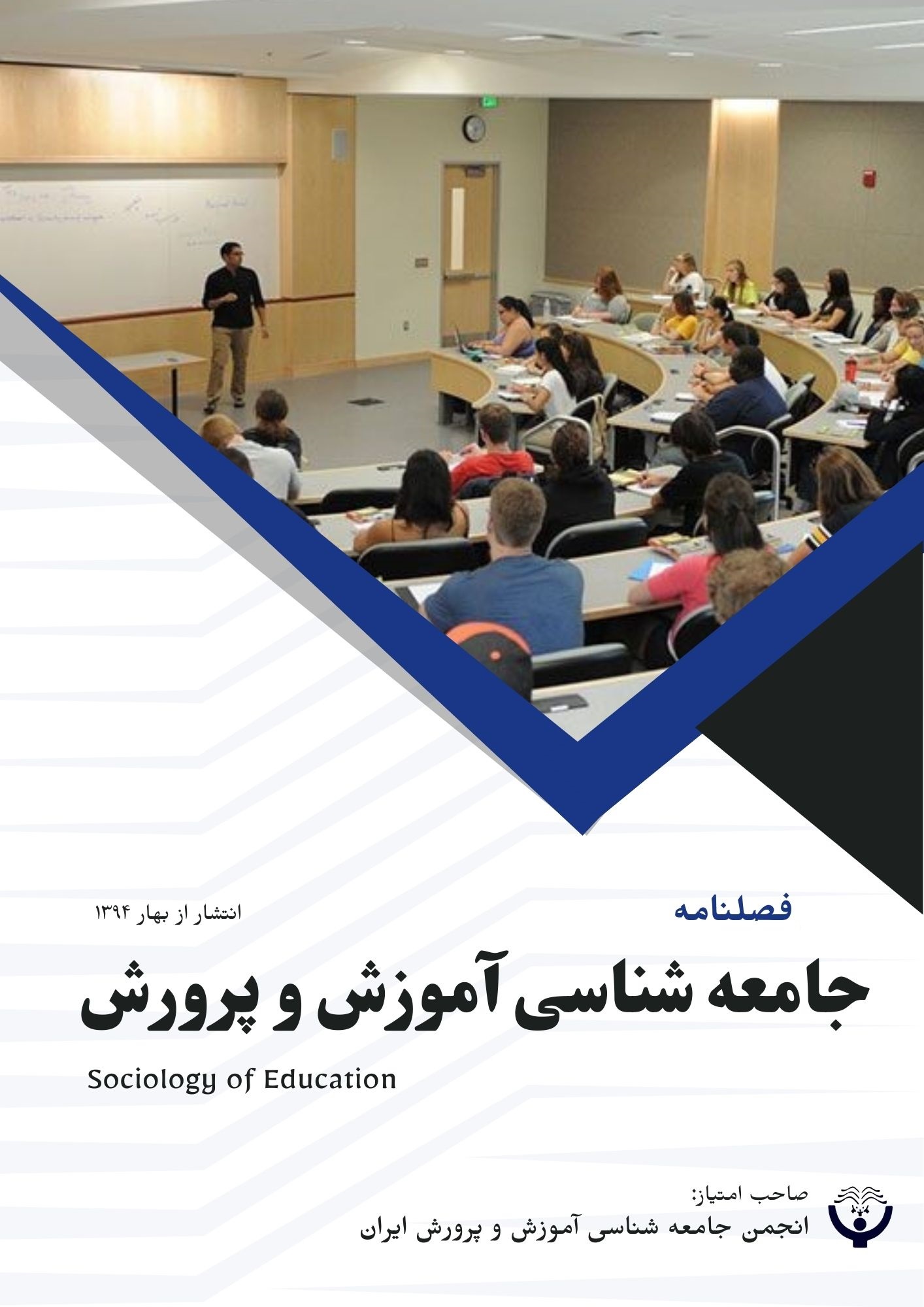ارائه الگوی مدل ساختاری بیموبایلهراسی براساس خودآگاهی هیجانی با میانجیگری پریشانی روانشناختی در دانشجویان
کلمات کلیدی:
بیموبایلهراسی, خودآگاهی هیجانی, پریشانی روانشناختی, مدلسازی معادلات ساختاری, دانشجویانچکیده
هدف: هدف پژوهش تبیین مدل ساختاری بیموبایلهراسی براساس خودآگاهی هیجانی با نقش میانجی پریشانی روانشناختی در میان دانشجویان بود.
روششناسی: این پژوهش از نوع توصیفی–همبستگی و مبتنی بر معادلات ساختاری بود. جامعه آماری شامل دانشجویان دانشکده تعلیم و تربیت (گروه روانشناسی و مشاوره) دانشگاه آزاد اسلامی واحد کرج در نیمسال دوم ۱۴۰۳–۱۴۰۴ بود. حجم نمونه ۲۵۰ نفر بر اساس روش نمونهگیری در دسترس انتخاب شد. ابزارهای پژوهش شامل پرسشنامه بیموبایلهراسی یلدریام و کوریا (۲۰۱۵)، پرسشنامه خودآگاهی هیجانی گرنت و همکاران (۲۰۰۲) و پرسشنامه پریشانی روانشناختی کسلر و همکاران (۲۰۰2) بود. دادهها با SPSS22 و AMOS تحلیل و مدل ساختاری با شاخصهای برازش ارزیابی شد.
یافتهها: نتایج نشان داد خودآگاهی هیجانی به طور مستقیم پریشانی روانشناختی (β = -0.37، p ≤ 0.001) و بیموبایلهراسی (β = -0.54، p ≤ 0.001) را پیشبینی میکند. پریشانی روانشناختی نیز تأثیر مستقیم و مثبت بر بیموبایلهراسی داشت (β = 0.65، p ≤ 0.001). همچنین اثر غیرمستقیم خودآگاهی هیجانی بر بیموبایلهراسی از طریق پریشانی روانشناختی معنادار بود (β = -0.24، p ≤ 0.001). شاخصهای برازش مدل نشان دادند که مدل پیشنهادی از برازش مطلوب برخوردار است.
نتیجهگیری: نتایج بیانگر آن است که خودآگاهی هیجانی میتواند از طریق کاهش پریشانی روانشناختی، سطوح بیموبایلهراسی را کاهش دهد. بنابراین توجه به مهارتهای هیجانی و عوامل آسیبشناختی در برنامههای آموزش و مداخله دانشگاهی ضروری است.
دانلودها
مراجع
Abdoli, N., Bahmani, D., Salari, N., Khodamoradi, M., Farnia, V., Jahangiri, S., & Brand, S. (2023). Nomophobia (No Mobile Phone Phobia) and Psychological Health Issues Among Young Adult Students. European Journal of Investigation in Health Psychology and Education, 13(9), 1762-1775. https://doi.org/10.3390/ejihpe13090128
Aldhahir, A., Bintalib, H., Siraj, R., Alqahtani, J., Alqarni, O., Alqarni, A., & Alwafi, H. (2023). Prevalence of Nomophobia and Its Impact on Academic Performance Among Respiratory Therapy Students in Saudi Arabia. Psychology research and behavior management, 16, 877-884. https://doi.org/10.2147/PRBM.S404898
Alizadeh, M., Miyan Bandi, G., Ashouri, A., & Hosseini, M. (2020). Investigating the Relationship Between Nomophobia and Sleep Quality in Students. 6th International Conference on Psychology, Educational Sciences, and Lifestyle,
Argumosa‐Villar, L., Boada‐Grau, J., & Vigil‐Colet, A. (2017). Exploratory Investigation of Theoretical Predictors of Nomophobia Using the Mobile Phone Involvement Questionnaire (MPIQ). Journal of adolescence, 56, 127-135. https://doi.org/10.1016/j.adolescence.2017.02.003
Ayala, M. J., Alegre de la Rosa, O. M., Chambi Catacora, M. A. D. P., Vargas Onofre, E., Cari Checa, E., & Díaz Flores, D. (2025). Nomophobia, phubbing, and deficient sleep patterns in college students. Frontiers in Education, 9, 1421162. https://doi.org/10.3389/feduc.2024.1421162
Cerniglia, L., Cimino, S., Marzilli, E., Pascale, E., & Tambelli, R. (2020). Associations Among Internet Addiction, Genetic Polymorphisms, Family Functioning, and Psychopathological Risk: Cross-sectional Exploratory Study. Jmir Mental Health, 7(12), e17341. https://doi.org/10.2196/17341
Choi, N. G., Sullivan, J. E., DiNitto, D. M., & Kunik, M. E. (2019). Associations Between Psychological Distress and Health-Related Behaviors Among Adults With Chronic Kidney Disease. Preventive Medicine, 126, 105749. https://doi.org/10.1016/j.ypmed.2019.06.007
Chowdhury, N., Kevorkian, S., Hawn, S. E., Amstadter, A. B., Dick, D., Kendler, K. S., & Berenz, E. C. (2018). Associations Between Personality and Distress Tolerance Among Trauma-Exposed Young Adults. Personality and individual differences, 120, 166-170. https://doi.org/10.1016/j.paid.2017.08.041
Davari, A., & Rezazadeh, A. (2018). Structural Equation Modeling with PLS Software. https://elmnet.ir/doc/31443680-21402
Derbich, J., Kuk, A., & Milde, K. (2024). The Smartphone That Cannot Be Abandoned - The Phenomenon of Nomophobia Among Students. Kwartalnik Naukowy Fides et Ratio, 58(2), 27-37. https://doi.org/10.34766/fetr.v58i2.1272
Elhai, J., Hall, B., Levine, J., & Dvorak, R. (2018). Types of Smartphone Usage and Relations With Problematic Smartphone Behaviors: The Role of Content Consumption vs. Social Smartphone Use. Cyberpsychology Journal of Psychosocial Research on Cyberspace, 11(2). https://cyberpsychology.eu/article/view/7069
Gohar, A., & Munir, M. (2022). Attachment Styles and Nomophobia in Young Adults: The Mediating Role of Mindful Awareness. Pakistan Journal of Psychological Research, 37(4), 637-652. https://doi.org/10.33824/PJPR.2022.37.4.38
Gómez-Salgado, J., Andrés-Villas, M., Domínguez-Salas, S., Díaz-Milanés, D., & Ruiz-Frutos, C. (2020). Related Health Factors of Psychological Distress During the COVID-19 Pandemic in Spain. International journal of environmental research and public health, 17(11), 3947. https://doi.org/10.3390/ijerph17113947
Gyasi, R. M. (2019). Social Support, Physical Activity and Psychological Distress Among Community-Dwelling Older Ghanaians. Archives of Gerontology and Geriatrics, 81, 142-148. https://doi.org/10.1016/j.archger.2018.11.016
Hamzaa, H., Atta, M., Omar, M., Machaly, E., Amin, S., & Wahba, N. (2024). Examining Nursing Students' Prevalence of Nomophobia, and Psychological Alienation and Their Correlates with Fear of Missing Out: A Multisites Survey. Sage Open Nursing, 23779608241301223. https://doi.org/10.1177/23779608241301223
Hussien, R. (2022). The Association Between Nomophobia and Loneliness Among the General Population in the Kingdom of Saudi Arabia. Middle East Current Psychiatry, 29(1). https://mecp.springeropen.com/articles/10.1186/s43045-022-00235-8
Kafi Nia, F., & Farhadi, H. (2020). The Effectiveness of Group Cognitive Behavioral Therapy on Emotional Self-Awareness and Problem-Solving Skills of Students Addicted to the Internet. Journal of Psychological Sciences, 19(85), 111-120. https://psychologicalscience.ir/article-1-344-en.html
Kessler, R. C., Andrews, G., Colpe, L. J., Hiripi, E., Mroczek, D. K., Normand, S. L., & Zaslavsky, A. M. (2002). Short Screening Scales to Monitor Population Prevalences and Trends in Nonspecific Psychological Distress. Psychological medicine, 32(6), 959-976. https://doi.org/10.1017/S0033291702006074
Khan, S., Atta, M., Malik, N. I., & Makhdoom, I. F. (2021). Prevalence and Relationship of Smartphone Addiction, Nomophobia, and Social Anxiety Among College and University Late Adolescents. İlköğretim Online, 20(5). https://ilkogretim-online.org/index.php/pub/issue/view/56
Kukreti, S., Ahorsu, D., Strong, C., Chen, I., Lin, C., Ko, N., & Pakpour, A. (2021). Post-Traumatic Stress Disorder in Chinese Teachers During COVID-19 Pandemic: Roles of Fear of COVID-19, Nomophobia, and Psychological Distress. Healthcare, 9(10), 1288. https://doi.org/10.3390/healthcare9101288
León-Mejía, A. C., Gutiérrez-Ortega, M., Serrano-Pintado, I., & González-Cabrera, J. (2021). A Systematic Review on Nomophobia Prevalence: Surfacing Results and Standard Guidelines for Future Research. PLoS One, 16(5), e0250509. https://doi.org/10.1371/journal.pone.0250509
Lian, S., Sun, X., Niu, G., Yang, X., Zhou, Z., & Yang, C. (2021). Mobile Phone Addiction and Psychological Distress Among Chinese Adolescents: The Mediating Role of Rumination and Moderating Role of the Capacity to Be Alone. Journal of affective disorders, 279, 701-710. https://doi.org/10.1016/j.jad.2020.10.005
Mahna, S., & Talab Pasand, S. (2016). The Relationship Between Environmental Support and Emotional Self-Awareness with Academic Engagement: The Mediating Role of Academic Well-being. Iranian Journal of Medical Education, 16, 31-42. https://ijme.mui.ac.ir/browse.php?a_id=3795&sid=1&slc_lang=fa
Mechraoui, O., Jelleli, H., Feikh-Romdhane, F., Rebhi, M., Saidane, M., Guelmami, N., & Dergaa, I. (2023). The Relationship Between Nomophobia and Psychological Distress in Tunisian Students: The Moderating Effect of Physical Activity. TJSSM, 8-19. https://doi.org/10.61838/kman.tjssm.1.1.3
Mozafari, M., & Ghayrati, S. (2023). Predicting Nomophobia Based on the Role of Self-Esteem and Feelings of Loneliness in Youth. 1st International Conference on Psychology, Social Sciences, Educational Sciences, and Philosophy,
Notara, V., Vagka, E., Gnardellis, C., & Lagiou, A. (2021). The Emerging Phenomenon of Nomophobia in Young Adults: A Systematic Review Study. Addiction & Health, 13(2), 120. https://pubmed.ncbi.nlm.nih.gov/34703533/
Notara, V., Vagka, E., Lagiou, A., & Gnardellis, C. (2023). Perceived Health and Nomophobia Among Young Adults: The Mediating Role of Depression and Stress. Sustainability, 16(1), 96. https://doi.org/10.3390/su16010096
Panova, T., & Carbonell, X. (2018). Is Smartphone Addiction Really an Addiction? Journal of Behavioral Addictions, 7(2), 252-259. https://doi.org/10.1556/2006.7.2018.49
Rahme, C., Hallit, R., Akel, M., Chalhoub, C., Hachem, M., Hallit, S., & Obeïd, S. (2021). Nomophobia and Temperaments in Lebanon: Results of a National Study. Perspectives in psychiatric care, 58(4), 1607-1612. https://doi.org/10.1111/ppc.12968
Sheikh, B., Hariri, N., Alqahtani, M., Aljabri, A., Eterji, A., Almutawa, S., & Alhejaili, A. (2024). Prevalence and associated factors of nomophobia amongst the general population in Makkah province and Al-Madinah province, Saudi Arabia: an analytical cross-sectional study. Clinical Practice and Epidemiology in Mental Health, 20(1). https://doi.org/10.2174/0117450179311620240508105100
Teasdale, T. W., & Antal, K. (2016). Psychological Distress and Intelligence in Young Men. Personality and individual differences, 99, 336-339. https://doi.org/10.1016/j.paid.2016.05.016
Tuco, K., Castro-Díaz, S., Soriano-Moreno, D., & Benites‐Zapata, V. (2023). Prevalence of Nomophobia in University Students: A Systematic Review and Meta-Analysis. Healthcare informatics research, 29(1), 40-53. https://doi.org/10.4258/hir.2023.29.1.40
Uguz, G., & Bacaksız, F. (2021). Relationships Between Personality Traits and Nomophobia: Research on Nurses Working in Public Hospitals. Perspectives in psychiatric care, 58(2), 673-681. https://doi.org/10.1111/ppc.12834
Walsh, S. P., White, K. M., & Young, R. M. (2010). Needing to Connect: The Effect of Self and Others on Young People's Involvement with Their Mobile Phones. Australian Journal of Psychology, 62(4), 194-203. https://doi.org/10.1080/00049530903567229
Yildirim, C., & Correia, A. P. (2015). Exploring the Dimensions of Nomophobia: Development and Validation of a Self-Reported Questionnaire. Computers in human Behavior, 49, 130-137. https://doi.org/10.1016/j.chb.2015.02.059
دانلود
چاپ شده
ارسال
بازنگری
پذیرش
شماره
نوع مقاله
مجوز
حق نشر 2025 Moeen Ghanizadeh Khajeh Pasha (Author); Mohsen Mansoubifar; Mohammad Reza Belyad, Masoumeh Zhian Bagheri, Javid Peymani (Author)

این پروژه تحت مجوز بین المللی Creative Commons Attribution-NonCommercial 4.0 می باشد.










